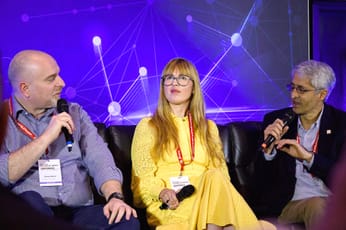#b2bhuddle : Kimberley Brind
Liveblogging: errors, grammar mistakes and odd sentence structure likely…
**Kimberley Brind, global marketing executive and social strategist, Oracle**
** **
She’s going to talk about a controversial topic: ROI. Most people just roll their eyes at it. Doe sit matter? When and how do you measure it? Are the efforts worth the time and investment? That’s what she’s going to talk about.
She’s one of Oracle’s global social leaders. She’s worked right across the company over the last decade, which has helped inform her latest role. Two years ago she was asked to set up a global team to look at what they should be doing from a social marketing point of view. They’ve learnt a lot, they keep learning and they realise they must change and adapt in such a fluid environment.
The statistics about social media are amazing. Only a few years ago she had debates with colleagues who thought it was a fad, or inapplicable to B2B. That’s not the case any more. The social era is here, now, and we have to engage with it. Social marketing matters to B2B companies because it’s all about competitive advantage and big data. She was interviewed for a role with a company that had no social presence – but came to the conclusion she didn’t want to work with a company without that awareness.
What we need to try and do is measure the effectiveness of your work. You cannot go to the board with anecdotal proof. You have to go to the board and prove an ROI, or you can’t secure your headcount and marketing spend. Marketing is about telling good story – and you need a good story for the board. It’s about moving the needle and making progress. Social in B2B has been hindered by the “if you can’t measure it, don’t do it” mentality. So, how did they do it?
They watch and measure lots of different social interactions, but they wanted to tie it back to pipeline. It’s all about demand generation and making profitable progress.
Everything comes back down to content. It’s not about broadcasting content – it’s about user-generated and crowd-sourced content. To achieve that, you need to inspire. They have two KPIs: social opt-ins and registartions/leads
She thinks there’s more value in a social opt-in because the recipient chooses when, what and how they here from you. It’s back in the recipients control, and counters the bad behaviours bred in e-mail marketing. They’re reaching a broader base of people. They have 80/20 content – 80 nurture/gift content, and 20% register-gated content. On average, they’re contenting with 40% more people than they would have done with e-mail only. And that’s translating to a 30% increase to leads to sales.
Brands need to be more human and empathetic. Humans want to be entertained, and marketeers need to be storytellers. You do that in the brand voice, and the brand context, but with a bit more fun. The BizCouch was launched a week or so ago – and they invited her in to talk. And then they invited her to have fun on a whiteboard – drawing the worse PowerPOint they’d seen, and playing a “What’s My Line” game about drawing their job. What a great way of inspiring user-generated content and starting conversations.
So, please join her on the couch and debate social ROI…
## Questions and Answers
**Does focus on ROI encourage people to doubt us?** No. We have to prove how we impact top line growth, and that’s absolutely right. it’s just an extension of the marketing mix. Not everything has to be tied back to pipeline. Reach and engagement are important metrics – but she likes to be able to tell the CEO what impact the spend had. Unless boards change, marketeers can’t get away from that.
**Are fans on Facebook really opted-in? Are e-mail opt-ins more valuable?** No for her. She prefers to communicate with people who have opted in to what we’ve got to say. Social is an extension of the mix. She sees it as a more valuable part of it.
**Real likes cost more than fake Likes. But the value varies – and is worth five times less than it costs to get?** She doesn’t know those numbers, so won’t comment on them. She gets an equal number of registrations through Facebook, Twitter and LinkedIn – she didn’t expect it from Facebook. And they’re the same quality into the sales funnel.
** **
**Are you measuring by content types? **Yes – most of their learning over the last 12 months has been in this. They seen most engagement with imagery and video, and open questions which trigger debates. Broadcast gets zero engagement. The unbeaten post was a photo of sales folks in the call centre in Dublin. It was so authentic – and that’s key to engagement.
**Do they watch competitors? **Yes, because it’s a learning journey.
**Are you measuring consumptive engagement, too?** Yes, that’s key. They’re going to start tracking consumptive behaviour. There’s an attitude that social is 90% voyeurs. That’s fine, if they’re consuming the content. We do want to measure that more. We’re good at jumping in and trying things. We haven’t figured out yet how to tie it in to ROI – but they will.
**Have they tied social into traditional CRM? **There’s a huge amount of work being done. They have a customer experience initiative that has multiple components. They’re tracking the social profiles of their customers, and making that available to their CRM.
Sign up for e-mail updates
Join the newsletter to receive the latest posts in your inbox.











